Matador Network's Blog, page 873
April 24, 2020
Asteroid looks like wearing mask

A 1.2-mile-wide asteroid is passing by Earth next week, and it is drawing attention for its appearance rather than its flight pass.
If you look really, really closely at the Doppler radar image of the asteroid named “1998 OR2,” and you really want to see it, the asteroid appears to be wearing a pandemic-appropriate face mask.
The “mask sighting” might sound like a stretch, but there is actual scientific rationale behind the asteroid’s unique aesthetic. Anne Virkki, head of planetary radar at Arecibo Observatory, said in a statement, “The small-scale topographic features such as hills and ridges on one end of asteroid 1998 OR2 are fascinating scientifically. But since we are all thinking about Covid-19, these features make it look like 1998 OR2 remembered to wear a mask.”
The asteroid is the largest expected to pass Earth within the next two months, and was classified as a potentially hazardous object due to its size and proximity to Earth’s orbit. It will be closest on April 29 at 5:56 AM ET, when it will come within 3,908,791 miles of Earth. 

More like this: NASA will show the cosmic wonders the Hubble Space Telescope captured on your birthday
The post An asteroid will pass by Earth next week, and it looks like it’s wearing a face mask appeared first on Matador Network.
April 23, 2020
Saba, Caribbean, travel
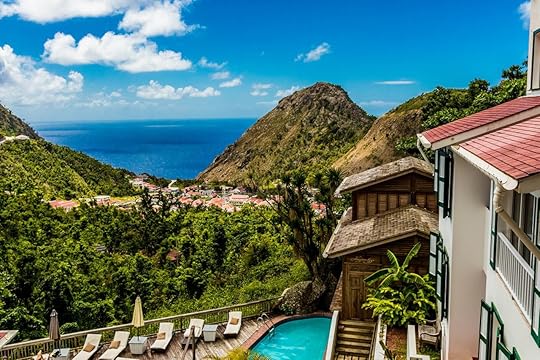
“Caribbean islands, man, they’re really all the same,” the older gentleman told me without my asking. We were sitting in an airport lounge in Miami, discussing where we were headed. He was flying to DC; I was going to the Caribbean. “You go there, there are some bars on the water, some stores, a mountain maybe. And that’s it!”
The man was a super-cruiser, the sort of person who takes every vacation on a floating city. And he was the particular subset of super-cruiser who never ventures much past the row of jewelry stores and fruity drink bars that line every port from Nassau to Newfoundland. Not to knock super-cruisers or cruise ports, mind you, but it seemed to me judging an entire region by its waterfront tourist traps seemed a little unfair.
“I dunno,” I said, not wanting to get into a heated debate with someone I’d likely never see again. “You ever been to Saba? It’s like nothing you’ve ever seen.”
“Saba? Never heard of it,” he said. “I don’t think anyone stops there.”
He was right. Saba isn’t even a blip on the large cruise ship radar, mostly because it’s one of the most physically difficult islands to reach in the Caribbean. It’s a harsh volcano about 30 miles from St. Maarten, five square miles with virtually no coastline, only reachable by ferry or prop plane.
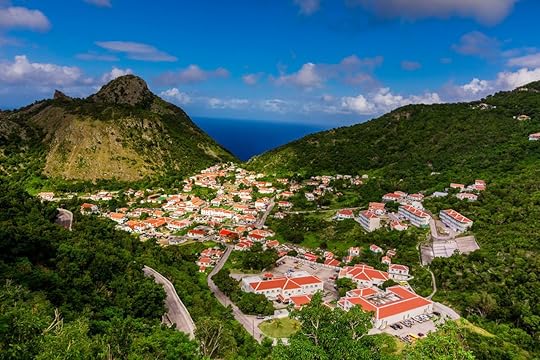
Photo: Laura Grier
This collection of white Dutch cottages with bright red roofs sticking up from a deep green volcano isn’t mega-port friendly. Its narrow alleyways and lone road aren’t fit for tour buses, and its airport is one of the most foreboding in the world.
But Saba is an escape from reality, a place that seems to stand still as a tranquil village on the side of a mountain. It’s full of characters that appear drawn from an author’s imagination. And though you’ll find modern technology, it still feels completely removed, a little tropical fantasy where the outside world never gets in.
“An innocent, original product” that’s welcoming to everyone
“It’s probably the most scenery I’ve ever seen packed into five square miles, and I’ve traveled all over the world,” says Mark Johnson, seated behind a desk at his jewelry store atop the Saban village of Windwardside. “It’s very dramatic. It’s very different. It has an old-world charm that’s been lost in a lot of the Caribbean, that’s just become a tourist destination. It’s an innocent, original product.”
You can find Johnson’s shop by walking the tight streets of Windwardside until you hear a loud chorus of birds chirping from a courtyard. Walk through a small archway and you’ll enter a jungle garden of tropical flowers and bird song. In the middle is a small white cottage where Johnson both lives and works with his partner. He uses sugar water in the bird feeders to keep the birds coming back and active.
You can find Johnson’s shop by walking the tight streets of Windwardside until you hear a loud chorus of birds chirping from a courtyard. Walk through a small archway and you’ll enter a jungle garden of tropical flowers and bird song. In the middle is a small white cottage where Johnson both lives and works with his partner. He uses sugar water in the bird feeders to keep the birds coming back and active.
Johnson’s partner will go unnamed here, as he hails from a part of the world where his sexual orientation isn’t welcomed, and his family believes he lives on another continent entirely. He was on the phone with his family while I spoke to Johnson, pausing briefly to bring us some espressos.
Saba is the most gay-friendly island I’ve seen in the Caribbean, where rainbow flags adorn the grocery stores and LGBT couples live freely and openly. Johnson says this stems from Saba’s place as part of the kingdom of the Netherlands. And because this island is so isolated, it’s managed to maintain its home country’s openness without influence from less-tolerant cultures of the region.
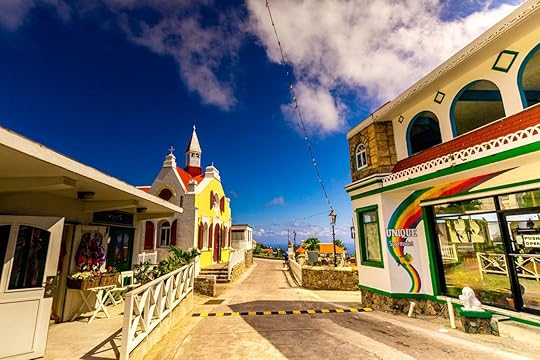
Photo: Laura Grier
A short walk down a steep road from Johnson’s shop brings you to Juliana’s hotel, a hillside boutique property with suites themed after famous Saban ship captains. Its signature feature is its sprawling (by Saban standards) pool, whose nightly sunset happy hour has become a social event for both visitors and locals.
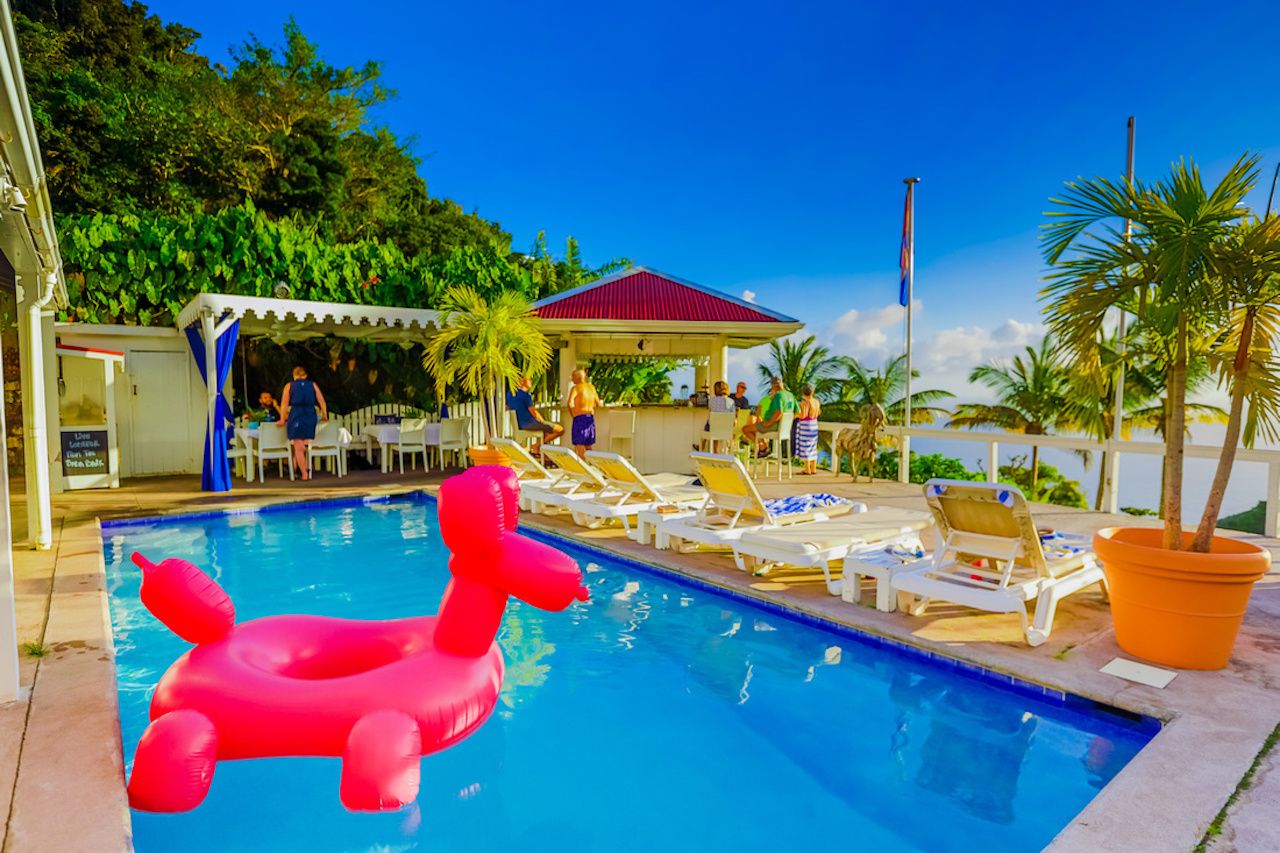
Photo: Laura Grier
I find myself chatting with an avid triathlete from Canada who has competed in Saba’s Hell’s Gate Triathlon. Its slogan: Even our swim is uphill. I also chat up a couple from St. Solomon’s Island, Georgia, who come to Saba for a couple of weeks every year. Nearly everyone here believes they’ve found some secret island hidden behind a forcefield off the coast of St. Maarten. Though we can see St. Eustatius and St. Kitts, it very much feels like no one on those islands can see us.
Hiking to the top of the Netherlands with Crocodile James

Photo: Laura Grier
“I rolled all these stones up here myself,” Crocodile James says as we hike through Saba’s newest hiking trail, the Elfin Forest. It begins just outside the village of Zion’s Hill, winding its way up the side of the volcano through bamboo, elephant ears, ferns, and short tropical shrubs. It seems especially Middle Earthy on this foggy, misty day.
Crocodile James — real name James Johnson (no relation to Mark, or maybe there is) — is the island’s default parks manager. He’s also a mason. And a fisherman. And a tour guide. His ramshackle white van is filled with power tools, paint, and gardening equipment. It might have space for one person — if he moves the leaf blower.
He built this trail and maintains others around the island, and he rolled the stones that give the muddy path some traction up the hill by hand. This seems difficult until he tells me these trails were how people moved everything from food to furniture before they built The Road, the island’s lone thoroughfare, built in 1938.
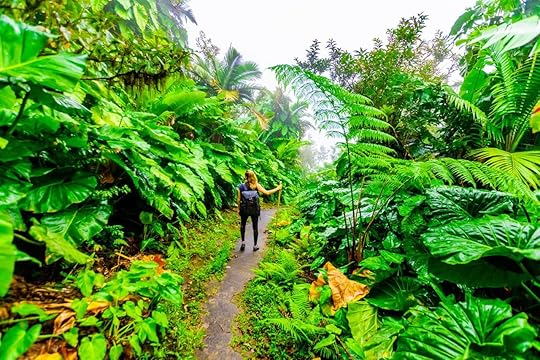
Photo: Laura Grier
Those paths and trails have left Saba with some of the best hiking in the Caribbean, where after finishing your magical trek through the Elfin Forest you can meet up with the Mt. Scenery trail and take it to the top of the mountain, the highest point in the Kingdom of the Netherlands. The full Mt. Scenery trail starts in Windwardside, and you can scale the 1,064 steps to the summit for a view out over the entire island.
The island is also known for its diving, especially since Leonardo DiCaprio rescued a man who fell off a boat here last year. The reefs here are largely undisturbed as tourists haven’t discovered them en masse, and you can see stingrays, sharks, sea turtles, and loads of colorful fish without many other boats around. It might be the only dive destination where the feeling of isolation and calm you feel under the water carries over to the surface as well.
A short runway to a great escape
Perhaps Saba feels like such a dream because getting there feels just as surreal. About 10 minutes after taking off from St. Maarten — the only airport with flights to Saba — an imposing volcano fills the windshield of the 30-seat propeller plane. Pilots look as if they’re going to fly straight into the side of it before banking left and descending into what looks like a sea of rocks with waves crashing into the side.
Just as you wonder where, exactly, these pilots are planning to land, the plane turns a corner and you see a tiny runway at the base of the volcano, as out of place as if an aircraft carrier had pulled up ashore. The plane glides down and screeches to one of the most violent stops you’ve ever felt on an airplane. Impressive, on the shortest commercial runway in the world at 400 meters.
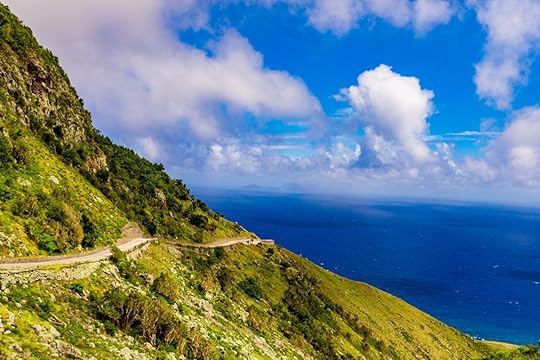
Photo: Laura Grier
From there it’s a windy ascent into the clouds, as the road takes you through the village of Zion’s Hill and on to Windwardside. Somehow, you’ve left the Caribbean and landed in the Dutch countryside, magically transported to the side of a volcano.
With a population of about 2,000 — 500 of whom are seasonal medical school students — Saba is very much a small town. By your second day, everyone on the island will know who you are and where you’re from. Your cab driver may also be your airport porter, who may also be your bartender at the end of the night.
Eating dinner at Brigadoon — arguably the best restaurant on the island — you may find yourself seated next to the entire territorial government, having a post-session dinner. There is no security or even anyone disturbing their dinner because there’s no need for either.
Further up the hill, you can visit the handful of bars that make up Saban nightlife at the Swinging Doors and Long Haul Grill. They’re the kind of bars that are filled with people who all know each other but welcome you all the same.
If you’d like to eat without people chatting you up, the Queen’s Gardens resort near the capital village of The Bottom has a treehouse table, with elevated views of the water peeking out from the volcano’s arms. It’s the lone luxury property on the island and boasts large suites plus a swimming pool with the same mountain-framed view.
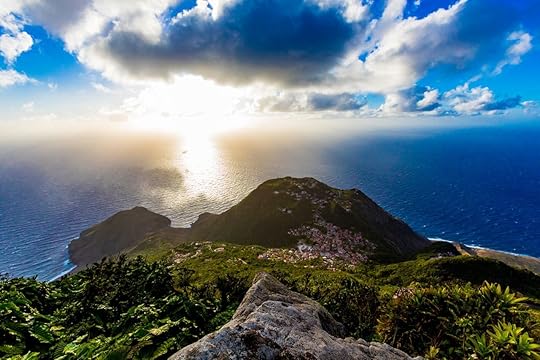
Photo: Laura Grier
But magical as Saba is, the locals don’t seem worried about over-tourism.
“It doesn’t have what a general tourist is looking for,” Johnson says, not trying to keep people away but just stating the obvious. “There’s no sandy beach, no way to just be entertained. It doesn’t have resorts, there are no casinos, there’s no nightlife. You have to entertain yourself. And it’s not typical of what people are looking for in a Caribbean island. But still, most of the people that come here really like it.”
A newer, larger port is coming to the island soon, though not large enough for cruise ships. So while it’s expected to bring more tourists, many locals still see it as a good thing.
“It concerns some locals,” Crocodile James says as he points to where the port will be. “But personally myself, once that’s built it’ll be good. It’ll end up bringing revenue and money towards that island. They could do with more tourists.”
For the most part, Sabans don’t believe tourists change their way of life, mostly because it’s stayed so much the same for so long.
I didn’t launch into this long of a story to my friend at the airport lounge, but he did at least raise an eyebrow when I told him about it and mumbled something along the lines of, “I’ll have to go check that out.” He may well never venture past Maho Beach on his next cruise ship call in St. Maarten, but I’d like to think I at least planted a seed in the back of his head. And he’ll know there’s at least one island in the Caribbean that’s like nothing he’s ever seen. 

More like this: The ultimate road trip guide to Dominica
The post The Caribbean’s most magical island is one most tourists have never heard of appeared first on Matador Network.
Main tea regions in Asia

While searching for edible herbs, the divine farmer Shennong, the mythological emperor of China credited with introducing China to agriculture and inventing the cart and plow, poisoned himself over and over. Just as the poisons were about to take his life, a leaf drifted into his mouth. He chewed it and discovered his body had healed. That’s how China discovered tea, or cha in Mandarin. At least according to legend.
The truth is a little less romantic but no less interesting: According to a brief history of tea written by historian Shunan Teng, the first teas were cultivated in China around 6,000 years ago, though the tea leaves were first cooked like vegetables or eaten with porridge. Tea became one of China’s most prized exports alongside porcelain and silk. Tea spread from China across the globe through both trade and colonialism.
Today, tea is the most popular drink on the planet, second only to plain water. But at its core, tea is integral to the identity, culture, and politics of the Asian continent. The two are inseparable. Europe, and in England in particular, might have staked its own claim to tea-drinking traditions, but the continent had no idea tea existed until the 16th century, and the first European country to import tea from Asia was the Netherlands, not England. Dutch traders first imported tea from Japan to Europe in the 1600s.
A Portuguese princess named Catherine of Braganza, who married King Charles II in 1662, is generally credited with popularizing tea as a drink of the elite in England, but it didn’t become the staple of British culture it is today until Anna, Duchess of Bedford, began serving it at lunch around 1840.
Today, the most popular and best-tasting teas are still sourced almost exclusively from Japan, India, China, Sri Lanka, and Taiwan (however, several countries in Africa and South America now grow tea as well). Each country has its own regions and specialties. Taiwan specializes in oolong, for example, while Japan favors green tea.
Here is a brief primer on the history and tea specialties of the five major tea growing countries.
1. China
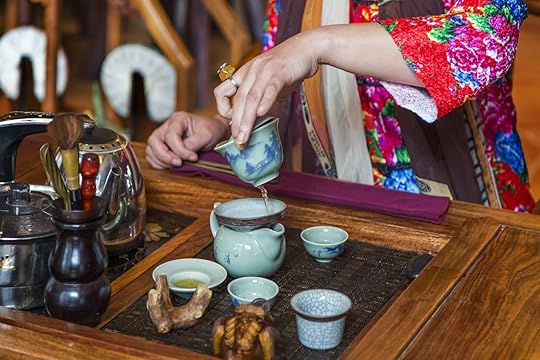
Photo: hxdyl/Shutterstock
Tea is the beating heart of Chinese art, cuisine, politics, and philosophy. According to Michael Freeman and Timothy O’ffay’s book The Life of Tea, Chinese farmers were almost certainly the first people to domesticate tea plants and cultivate them commercially. China is still the largest producer of tea on the planet, cultivating around 35 percent of the tea exported across the globe. It’s also the world’s largest consumer of tea, drinking around 1.6 billion pounds of tea leaves every year.
There are four major tea growing regions in China: Jiangbei (north of Yangtze river), Jiangnan (south of Yangtze river), Southern China, and Southwest China. These cover 18 provinces and produce oolong, green, black, white and rare yellow teas.
The Zhejiang province is famous for its green tea, and longjing (or dragon well) tea in particular. Longjing’s jade leaves are harvested in April and prized for their nutty, toasted, warm aromatic flavors. Meanwhile, in Anhui province, the speciality is black tea. Qimen, harvested in Anhui, is China’s premiere black tea and is featured prominently in many English Breakfast blends. The foggy mountains in the region let in little sunlight, which increases the chlorophyll level of the Qimen tea leaves, resulting in a fruit forward, floral, and more mellow black tea.
China also specializes in oolong teas, and the Phoenix Mountains in Guangdong produce some of the best in the world. These tea plants are not pruned into bushes but rather cultivated into full grown trees. The resulting teas are called dan cong, or single bush oolong, because each batch must be picked from an individual tree, or at least from the same grove of trees.
2. India
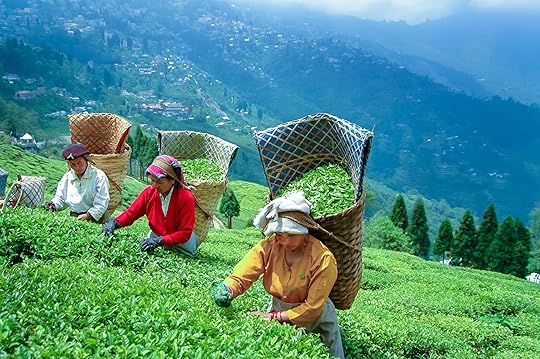
Photo: Ron Ramtang/Shutterstock
According to some legends, masala chai has been consumed in India for at least 5,000 years as a medicinal Aruyvedic beverage, and Camellia sinensis grows wild throughout the country. However, the first commercial tea plantations in India were established by the British in 1834 in an effort to abolish China’s monopoly on the tea trade. By the 1700s, the British were buying millions of pounds of tea from China every year, and they were running out of ways to pay for it. They tried opium, but China banned it in 1729, which resulted in more than a century of illegal smuggling and two Opium Wars. According to Michael Freeman and Timothy O’ffay’s book The Life of Tea, the British needed a steady supply of tea that wasn’t tied to the tumultuous political situation in China. The first seeds were planted in the Calcutta Botanical Gardens, and the resulting 200,000 plants were spread throughout India’s three main tea-growing regions: Darjeeling, Nigiri Hills, and Assam.
Potent black breakfast teas, which are typically described as having a malty or honey flavor, are grown in Assam. The Darjeeling region in West Bengal is more diverse and produces black, green, white, and oolong tea from the Camellia sinensis, rather than assamica, plant. In the smaller Nilgiri Hills region, fragrant and smooth black teas flourish though they are less well known than their cousins in Darjeeling and Assam.
3. Sri Lanka
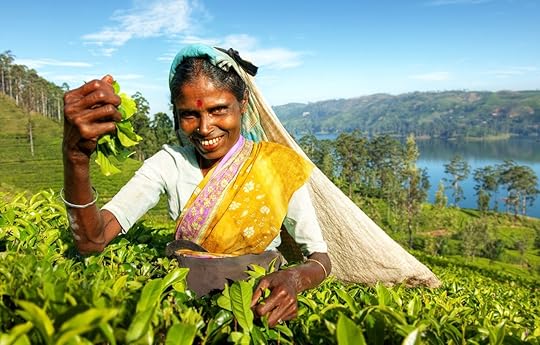
Photo: Rawpixel.com/Shutterstock
In 1824, British merchants brought the first tea plants to what was then called Ceylon and is now known as Sri Lanka. Commercial tea growing would not begin in Sri Lanka for another 43 years when a businessman named James Taylor planted a tea plantation on his estate. The Sri Lankan tea business didn’t really take off until around 1890, however, when Thomas Lipton, at the time a grocery store mogul, stopped by Ceylon on his way home from vacation. Eager to sell what would become known as instant tea in his shops (tea leaves sold in packets rather than as loose leaves), he purchased three former coffee plantations and set up his tea-growing operations.
Black tea takes precedence in Sri Lanka. According to Freeman and O’ffay, Sri Lanka’s many tea-growing regions are divided into three categories: high-grown and mid-grown (subtle and delicate flavors) and low-grown (more robust). There are seven signature tea growing regions in Sri Lanka: Nuwara Eliya, Dimbula, Uva, Uda Pussallawa, Ruhuna, Sambaragamuwa, and Kandy, with flavors that range from mellow, to tangy, to full bodied.
4. Japan
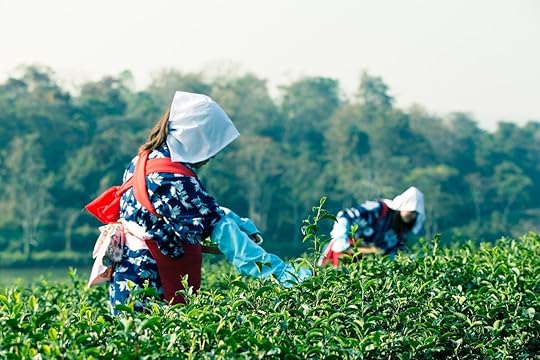
Photo: Vilasack Southisane/Shutterstock
In the 12th century, a Buddhist monk named Eisai went on a pilgrimage to China and brought the first tea plants back to Japan. Since then, Japan has developed its own rich traditions and rituals around the beverage. In the 16th century, Rikyu Sen, a tea master, introduced the art of the tea ceremony to Japanese society. There are at least six major tea growing regions in Japan, arguably the most famous of which are Shizuoka and Uji.
Although Shizuoka produces the most tea in Japan, accounting for 40 percent of the country’s tea plantations, it’s generally agreed that Uji produces the best-tasting tea. Known as Uji Gyokuro, it is the highest grade Japanese green tea. This tea is shade-grown, which increases the chlorophyll in the leaves, resulting in a bright green hue and a creamy, sweet flavor.
Today, green tea, or ryokucha, is by far the most widely produced and consumed tea in Japan and is beloved for its medicinal properties. Green tea is consumed in two principle ways in Japan: Sencha, the most widely consumed variety of green tea in Japan, involves simply infusing the whole dry tea leaves in hot water. Matcha, which recently grew more popular in the West, is finely ground green tea leaf powder that can be infused into noodles, ice cream, and coffee.
5. Taiwan
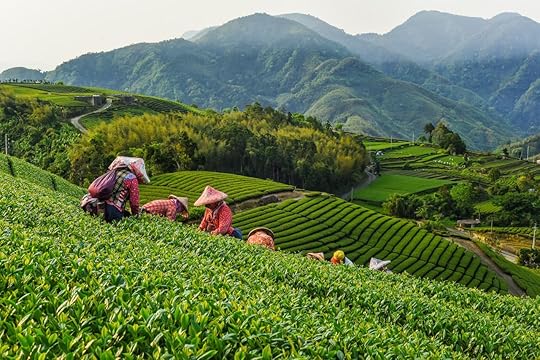
Photo: weniliou/Shutterstock
In modern Taiwan, a common greeting to guests is, “Come in and drink tea,” but the Dutch East India Company is responsible for introducing the island to tea. In 1623, the company used Taiwan as its base of operations for trade between China and Japan. In the late 17th century, the company reported that wild tea leaves were found growing in Taiwan. Still, at first the Dutch East India Company only commercially farmed sugar and rice in Taiwan. Soon, however, traders from Fujian province in China brought over tea trees, which thrived in Taiwan’s climate.
It wouldn’t be until the mid-19th century that the tea trade would really take off in Taiwan however. In 1855, small oolong trees were imported from the Wuyi Mountains in China, which resulted in a now prized variety of Taiwanese tea called Dong Ding oolong. By 1970, oolong became the most beloved, and most widely cultivated, tea in Taiwan.
The Nantou region, home to Dong Ding oolong, is responsible for producing half the island’s tea. Sun Moon Lake in Nantou also cultivates Taiwan’s most renowned black tea, a sweet, rich variety called red ruby. In Pinglin, Taipei, tea plantations grow pouchong, an exceptional green-hued oolong famous for its floral aromas. 

More like this: How to make tea the Berber way
The post The 5 major tea regions of Asia you need to know about appeared first on Matador Network.
‘Follow me to home’ lockdown photos

Say what you want about the popular #followmeto Instagram trend, but it certainly lends itself to creativity. These days, rather than simply posting cliche photos of walking through a sunflower field, or onto a beach in Bali, people are evolving with the times and adapting their #followmeto posts to the pandemic era.
Given social distancing restrictions and the halt of international travel, “Follow me to [insert country here]” has become “Follow me to home,” and people are getting very inventive with their photos.
These pictures don’t ignite our sense of FOMO quite as bad as they used to. In fact, the “Follow me to home” trend is unique in its accessibility and relatability, depicting people in everyday domestic environments, connecting with family, and enjoying the little things. From having a little fun at work to cooking with grandma or spending quality time with your pet, here are some of the internet’s most creative #followmetohome moments.
The housework-obsessed
View this post on InstagramA post shared by Rohina Anand Khira (@aa.living) on Apr 20, 2020 at 11:37pm PDT
View this post on InstagramA post shared by (@gab.gam) on Apr 19, 2020 at 10:08pm PDT
View this post on InstagramA post shared by Sunnia Ali Khan (@sunniasays) on Apr 17, 2020 at 12:04pm PDT
View this post on InstagramA post shared by Косплеер • Cosplayer • Artist (@olga_mitranda) on Apr 4, 2020 at 11:16am PDT
View this post on InstagramA post shared by Ksenia VORON (@voron_ksyu) on Apr 20, 2020 at 3:47am PDT
The healthcare workers in need of levity
View this post on InstagramA post shared by ЛЮБЕРЦЫ Подмосковье (@mylubertsy) on Apr 20, 2020 at 9:57pm PDT
The couple that does everything together
View this post on InstagramA post shared by MILAD GHAMKHARI (@miladghamkhari) on Apr 16, 2020 at 10:50am PDT
The best part of being home is being with our family and pets
View this post on InstagramA post shared by Sarah Goodchild (@chidl88) on Apr 22, 2020 at 2:00am PDT
View this post on InstagramA post shared by Александра Коломиец (@santerchick) on Apr 22, 2020 at 8:50am PDT
View this post on InstagramA post shared by Силагадзе Анастасия (@anastasiia_sila) on Apr 4, 2020 at 10:30am PDT
The artists
View this post on InstagramA post shared by FlatlayFashionInspiration (@kris_zhuravleva_) on Apr 17, 2020 at 9:48am PDT
The hopefuls and the desperate
View this post on InstagramA post shared by MURAD OSMANN (@muradosmann) on Mar 17, 2020 at 10:28am PDT
View this post on InstagramA post shared by Ruta Heinman (@rutaheinman) on Apr 19, 2020 at 8:45pm PDT
View this post on InstagramA post shared by Саша/Sasha (@sashagrebenkova) on Apr 5, 2020 at 2:58pm PDT
The athletes
View this post on InstagramA post shared by Annalisa Bosin (@annalisabosin) on Apr 1, 2020 at 10:17am PDT
View this post on InstagramA post shared by (@elina_into_the_nature) on Apr 7, 2020 at 11:50pm PDT


More like this: Why traveling for the #gram is a terrible idea
The post ‘Follow me to home’ Instagram photos are the new hilarious trend appeared first on Matador Network.
The best barbecue sauce in the world
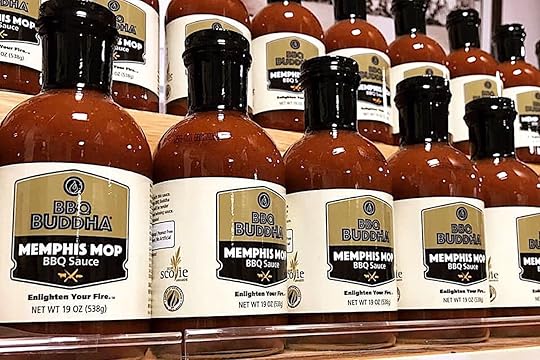
Barbecue sauce is a contentious subject. Styles vary depending on region, and recipes are closely guarded and hotly defended by barbecue aficionados. South Carolina Gold is mustard-based while Alabama prefers a mayonnaise and vinegar-based white sauce. Pitmasters in each region would probably contend that their version is the best in the world, but just one man can claim that title: Memphis-based pitmaster Ray Sheehan.
The San Diego Union-Tribune reports that, at a recent international barbecue competition in Louisiana, Sheehan’s Memphis Mop BBQ Sauce won the title of “Best BBQ Sauce in the World.” He’s also the author of a new book called Award-Winning BBQ Sauces and How to Use Them, and a judge for the Kansas City Barbecue Society.
Sheehan leaves out artificial ingredients like thickeners or sweeteners and says that his sauces take a lot of experimentation to get right. In his book, he writes that the perfect barbecue sauce should be balanced between sweet and spicy, but it should have a kick that leaves “the flavors lingering on your palate.”
His award-winning Memphis Mop recipe includes mustard, Heinz ketchup, brown sugar, Worcestershire sauce, and vinegar, among other ingredients. He also adds hickory liquid smoke at the end to give it that much-needed signature smoky barbecue flavor. Best of all, it only needs to simmer 25 minutes before it’s ready to slather on your favorite grilled or smoked meats.
If you’re spending lockdown grilling in the backyard, perfecting your barbecue sauce recipe under Sheehan’s tutelage isn’t a bad way to spend your time. Of course, if you’d rather stick to cooking steaks and leave the sauce to the experts, Sheehan sells his very own line called BBQ Buddha. 

More like this: This legendary Kansas City restaurant has a barbecue vending machine
The post This Memphis barbecue sauce is officially the best in the world appeared first on Matador Network.
Best summer day itinerary in Moscow
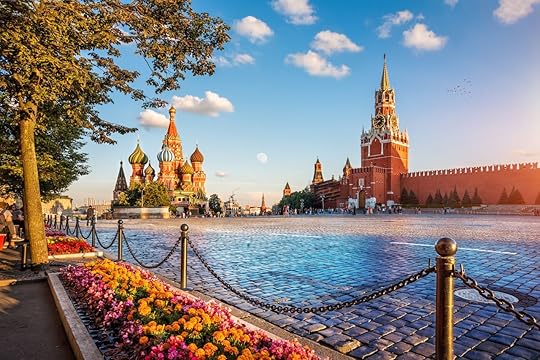
One of the tenets of Soviet culture is the ethic of “rise early, work hard,” and although much of Moscow has now embraced Western values, it would behoove you to lean into the “rise early” half of that value equation as Moscow has enough to see for several lifetimes.
Although Russia’s capital is lovely during all of the summer months, June — the peak of White Nights and local graduations — brings out the most celebratory spirits. The city is still fresh without the smog and oppressive heat of late summer, and although the poplar trees favored by the Soviet government are busy producing tons of fluffy pukh (white puffy seeds that resemble cotton), it’s arguably the best month to visit. Whether you’re stopping by for a day on a busy work trip or spending a summer backpacking through Europe, the magic of a perfect summer day in Moscow beckons. Spend it as follows.
Morning: breakfast in the park followed by a Soviet architecture tour
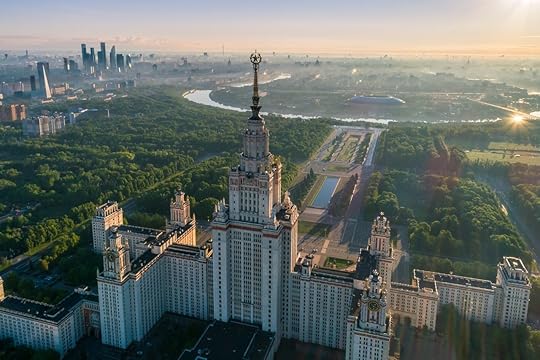
Photo: mzabarovsky/Shutterstock
If your budget includes a hotel stay, begin your morning with breakfast at the hotel cafe. Otherwise, if you’re staying at a hostel with friends or arriving in the morning, head to your neighborhood grocery store to fill up. Most grocery stores have a baked goods section where you’ll find pierogies stuffed with jam, cheese, meat, or cabbage, as well as sweet pastries. Grab a beverage and some fresh fruit, then find a sunny park bench to enjoy your food as you watch Muscovites go about their day.
Although cabs and rideshare services are easily available throughout the city, the metro is by far the easiest, fastest, and most pleasant way to get around. It takes you directly to popular sites, and where it doesn’t, buses and marshrutkas (small local vans that follow neighborhood routes) fill in the gaps. The system is relatively easy to figure out and route, despite being extremely comprehensive.
After breakfast, take the metro to Vorobyovy Gory (Sparrow Hills), a scenic overlook adjacent to the high-rise Moscow State University. It’s a popular destination with wedding parties vying for a photograph, so it’s best to arrive early to beat the crowds and get the views of the winding Moscow River to yourself. Once the tour buses start arriving, cross the street behind you to walk around the university grounds and admire the impressive, if austere, Soviet architecture. The university is one of seven similar buildings called the Stalinskie Vysotki (Stalin Skyscrapers) that dot the city. If it’s open, the university botanical garden is particularly lovely in June.
From here, cross the bridge to the Vorobyovy Gory Metro stop (on the red line), then take the train north into the city center, disembarking at the Okhotnyy Ryad stop. It’s located in the heart of the city and opens into a sprawling — and chaotic — underground shopping center. It’s worth a wander through here to hunt down last-minute gifts or souvenirs, before popping up in front of the State Historical Museum that flanks the right side of the entrance to the Red Square.
Afternoon: exploring the Red Square and its surroundings
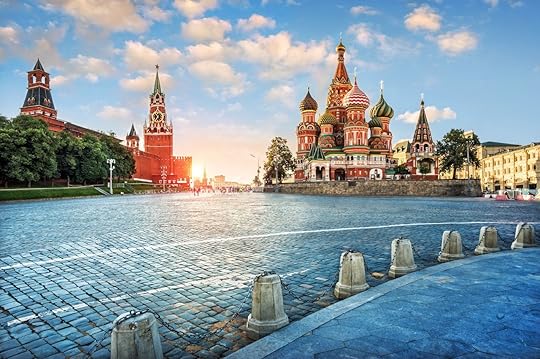
Photo: Baturina Yuliya/Shutterstock
The Red Square, which has been used for everything from political and military demonstrations to massive cultural events, is bordered to the left by the GUM (short for Gosudarstvennyi Universalniy Magazin, the city’s main Soviet shopping center) and to the right by the Lenin Mausoleum, where the Soviet leader’s body has been entombed for nearly a century. At the far end of the square sits St. Basil’s Cathedral whose iconic onion spires are recognizable even from a distance.
Although each of these attractions — the cathedral, the mausoleum, and the Kremlin complex that sprawls out behind it — warrants a visit, you’ll likely only have time for one if you choose to visit today. For a bird’s-eye view of the area, walk along the Kremlin wall that leads away from the Red Square to see the site of the Tomb of the Unknown Soldier and Aleksandrovskiy Sad, which offers views of the Kremlin entrance.
Back at the Red Square, pose for the obligatory photo with St. Basil’s Cathedral, then head to your left into the GUM for an unexpected dining experience. Formerly a central household shopping center during Soviet times, the marbled and glass-ceilinged monolith has been revitalized as a luxury brand hub, with stores like Hermes and Cartier open for business. Take a stroll through the airy balconies of the building before heading to the third floor’s Canteen No 57, a Soviet-era-style cafe with lunch options like borscht, sardine salad, and hearty rye bread. It’s important to note that the GUM has fantastic bathrooms in the basement and on the second floor, although you will have to pay a nominal fee to use them.
Evening: touring an iconic children’s store and dining on Arbat Street
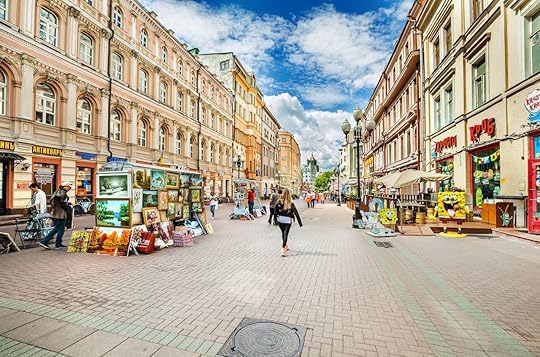
Photo: Olgysha/Shutterstock
Exit GUM to the north onto Nikolskaya St., then walk to your right to reach Ploschad Revolutsii. If the weather’s lousy, continue walking for a few blocks along Teatralny Proezd to reach Detskiy Mir (the Central Department Store for Children), a massive children’s shopping center with a small museum of Soviet toys on the top floor and an observation deck with views of the downtown. For dinner, catch a metro from Ploschad Revolutsii to Arbat Street, Moscow’s centrally located pedestrian shopping street. Here you’ll find everything from Russian food chains such as Teremok and Kroshka Kartoshka to international cuisine and one-off local favorites.
However, if the weather is clear, as it often is in June, and joyful Muscovites are out in full force, join romantic couples and cheerful families at VDNH, the All-Russian Exhibition Center (formerly All-Union Agricultural Exhibition). From nearby Lubyanka Station, it’s a 45-minute metro ride north to the Vystavochniy Tsentr stop, which opens directly onto the sprawling park’s main gates.
The park’s many buildings, which line the wide tree-lined pedestrian avenues, were built to showcase the many cultures of the Soviet Union and are each more ornate and impressive than the last. Between them, you’ll find various paths that lead to grill cafes serving sizzling shashlik (skewered meat) and cold beer, ice cream stands, and pop-up carnivals and attractions. In short, there are plenty of little eateries to grab food while people-watching and enjoying the warm evening.
General tips

Photo: Sergey Dzyuba/Shutterstock
Moscow’s metro system is huge, with a cornucopia of gilded underground stations to explore. It’s also surprisingly easy to navigate, as trains from each stop only head in two directions and always go to the same stops. Most trains and stations in the city center have been updated with English signs, and if you get lost, most young people know at least some English.
As an added perk, the Moscow Metro offers free WiFi for holders of Russian sim cards. If your phone has a removable sim card, it’s convenient and cheap to buy a Russian one for your stay. They’re sold at kiosks near most metro stops and in shopping centers. Simply pop the Russian sim into your phone, and — viola — a constant stream of internet. 

More like this: These 7 palaces in Moscow are straight out of a fairy tale
The post How to spend the perfect summer day in Moscow, Russia appeared first on Matador Network.
COVID-19 cause 'biblical' famine

As East Africa and South Asia grapple with one of the worst locust infestations in history, another Old Testament plague is about to hit the world in the coming months: famine. In its fourth-annual Global Report on Food Crises, the World Food Programme (WFP) — the United Nations’ food agency — found that the number of people facing starvation will almost double from 135 million to 250 million within a few months, due in large part to the global COVID-19 pandemic.
WFP Executive Director David Beasley warned it would be a famine “of biblical proportions.” As countries around the world experience the fallout from a global recession, aid donations have dropped, and vulnerable people who were a week’s worth of pay away from starvation now find themselves out of work. The worst-hit countries will be those already facing severe famine, including places like Yemen, Afghanistan, Venezuela, Ethiopia, South Sudan, and Haiti.
“One way or another, the world will pay for this,” Beasley told the UN Security Council via a video conference. “We could be facing multiple famines of biblical proportions within a few months. The truth is, we do not have time on our side.”
He went on to predict 30 million people may die within months if food aid is not received, particularly difficult in war-torn areas like Yemen, which was set to see half its aid cut in Houthi-controlled areas.
“Our analysis shows that 300,000 people could starve to death every single day over a three-month period,” Beasley said. “This does not include the increase of starvation due to COVID-19.”
A grim picture indeed, considering 100 million people worldwide depend on the WFP for food. He pleaded with warring nations, which are explicitly linked to famine in the annual report, to give “swift and unimpeded access” to humanitarian workers. He also asked for $350 million to create a global logistics network to get the food supply where it’s most needed.
Given that, Beasley was also cautiously optimistic.
“I do believe that with our expertise and our partnerships, we can bring together the teams and programs necessary to make certain the COVID-19 pandemic does not become a human and food crisis catastrophe,” he said.
Though there is certainly no shortage of deserving organizations helping those affected by COVID-19 right now, if you feel compelled to donate to the WFP, it accepts donations here. While the United States struggles with its own spiking unemployment and uncertain future, keep in mind there are a lot of places in the world that have it a lot worse. And though God has not smitten us with plagues quite yet, it’s always good to keep everything in perspective. 

More like this: A group of women in Venice is delivering groceries via gondola
The post ‘Biblical’ famines could occur due to COVID-19, says the United Nations appeared first on Matador Network.
Origin behind dalgona coffee
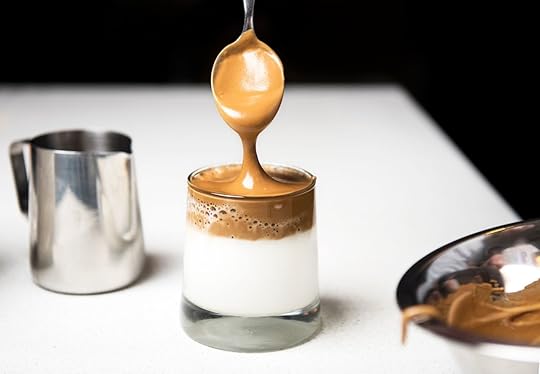
If you follow the ups and downs of quarantine trends, you’d have reason to believe that TikTok birthed a sweet, high-caffeine coffee drink called dalgona, which slowly, then quickly, took over our kitchens. Dalgona is a whipped drink made with instant coffee, sugar, and milk. Over the past month and a half, influencers, celebrities, and anyone with some spare time on their hands have put their forearms to good use to whip up this supposedly new coffee trend.
The only thing is that it’s far from new. Its modern popularity stems from a South Korean TV show, but similar whipped instant coffee drinks can be found around the world, including India, Pakistan, Greece, and Macau. This is the twisting, multi-layered story of how what’s now known as dalgona coffee came to be.
Why is it called dalgona coffee?
The name everyone knows today is just about the only straightforward piece of the dalgona coffee story. The current trend in the United States can be traced back to January in Korea, when a clip on a show called Stars’ Top Recipe at Fun-Staurant featured actor Jung Il-woo ordering a coffee in Macau.
In the show, a panel comments in real time on the video of the coffee being made. As a two-to-two ratio of instant coffee and sugar is whipped (400 times, according to the video), it turns to a light brown mixture. One of the commenters says, “Isn’t that like sweet sugar candy?” The candy in reference is dalgona, which means “honeycomb toffee” in Korean.
Dalgona is a candy that became popular after the Korean War in the early 1950s, according to the South China Morning Post. Parents looking to make affordable sweets for their children heated sugar and water and then added baking soda. When the mixture cooled, it became an airy candy that’s sweet at first and slightly bitter toward the end.
Our assistant food and drink editor Elisabeth Sherman tried to make dalgona coffee at home, by whipping together instant coffee, palm sugar, and two tablespoons of hot water with her hand mixer. The process didn’t go as smoothly as it does in some of the more popular TikTok videos: Counterintuitively, the hand mixer didn’t speed up the process, and when the ingredients did finally come together, it didn’t have the same satisfying cloudy, puffiness. Once it touched the milk in her glass it deflated almost instantly, but it did satisfy her latte craving.
YouTubers and social media stars who replicated the recipe from the original video clip had better luck: It has more than 12 million views at the time of this story, and the drink is now nicknamed dalgona coffee and 400 stir coffee. In the US, meanwhile, Google search trends show that “TikTok coffee” is one of the most popular ways people are searching for the recipe.
Who created dalgona coffee?
This is where things get complicated. Foods are not made in isolation, and several cultures have a type of whipped coffee made with sugar and instant coffee. Though people in the US and Western Europe typically prefer to use ground coffee beans, people in much of Asia, Eastern Europe, and parts of South America opt for instant, according to a report by the market research company Euromonitor.
The availability of instant coffee has led to variations on whipped instant drinks for decades. In India, it’s called phenti hui coffee. A writer for India’s Economic Times noted that the drink is “something which was a treat for countless Indians before the advent of fancy coffee bars and brands is now being remarketed on social media.” Vice reports that the hand-beaten coffee has long been popular in both Pakistan and India.
In Greece, the drink dates to 1957 and is called a frappe. There, the story goes, it was invented by a Nescafe representative and became so popular that it’s still sold in cafes and restaurants around the country. The drink is just as common in Libya as well.
In Macau, where Jung Il-woo tried the drink, the beverage stems from an abandoned shipyard. After nearly losing his arm during an industrial accident in the late 1980s, Leong Kam Hon opened a coffee shop called Hon Kee in 1990 to serve workers at the port. CNN spoke with him in 2013 and got the story on the “kung fu coffee master” (kung fu was one of the ways Leong Kam Hon rebuilt strength in his arm).
An English-speaking couple became yearly regulars at Hon Kee during the Grand Prix in the early 2000s. Leong Kam Hon never learned their nationality, but he did learn from them how to make a foamy coffee drink from whipped instant coffee. The actor Chow Yun-Fat, of Crouching Tiger, Hidden Dragon fame, visited Hon Kee in 2004 and loved the coffee. From then on, it became known as “Chow Yun-Fat coffee,” according to CNN. At least until Jung Il-woo showed up.
The rest of the story is modern internet history. Shortly after the Stars’ Top Recipe at Fun-Staurant clip made the coffee drink popular in Korea, it made it to the US with the help of TikTok user @imhannahcho.
“I never expected dalgona coffee to get this popular,” Jung Il-woo told the New York Times.
But if there’s one thing to know about internet food trends, it’s that it all has to start from somewhere, and all it takes is one person with a large following to make it popular. 

More like this: 7 unique ways people drink coffee around the world
The post The true origin of the internet-famous dalgona coffee appeared first on Matador Network.
Face mask appears on Banksy’s mural
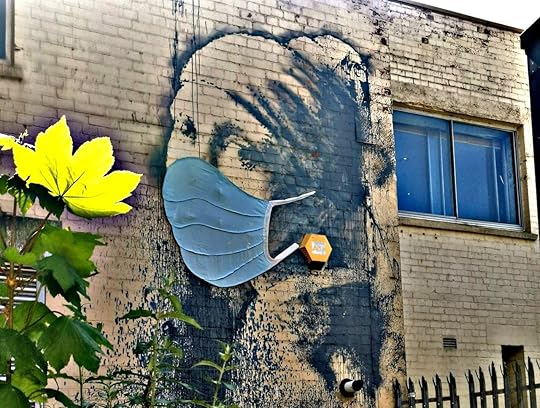
Street artist Banksy is famous both for his anonymity and the secrecy that surrounds the appearance of his artwork. And yesterday, another layer of mystery was added to one of Banksy’s notable works.
The mural, inspired by Dutch artist Johannes Vermeer’s “Girl with a Pearl Earring,” appeared on a harborside building in Bristol, England, in 2014, with the pearl replaced by a security alarm. As of April 22, 2020, the piece has been updated to be somewhat more topical.

Photo: bogdanm85/Instagram
A giant surgical face mask has been attached over the girl’s mouth, a clear acknowledgment of the current heightened health precautions everyone is taking during the COVID-19 pandemic. It’s unknown whether Banksy or someone else installed the fabric face mask, but the update is drawing as much attention as the initial mural itself.
Banksy hasn’t posted the work on his Instagram account, sparking some speculation that he isn’t responsible for the addition. His most recent confirmed work, however, is also a nod to today’s strange circumstances. On his Instagram, he revealed a version of his trademark scene of rats running amok on city streets — only this time, the stenciled rats are wreaking havoc in his own bathroom.
View this post on InstagramA post shared by Banksy (@banksy) on Apr 15, 2020 at 10:45am PDT
The caption reads, “My wife hates it when I work from home.” 

More like this: 7 of the world’s trippiest street art murals
The post A face mask has mysteriously appeared on Banksy’s ‘Girl with a Pierced Eardrum’ appeared first on Matador Network.
NASA ‘Pillars of Creation’ photos
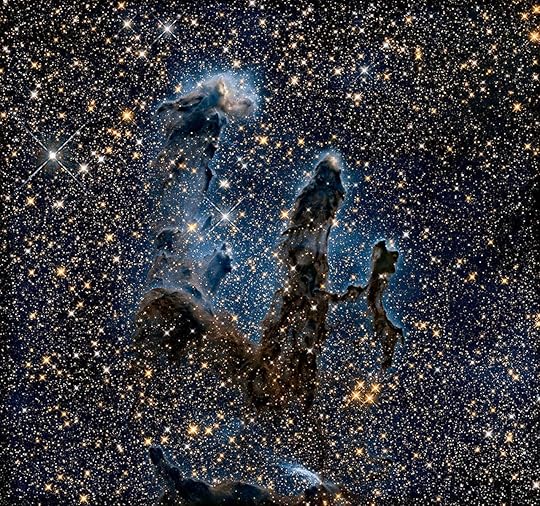
NASA’s Hubble Telescope has time and again managed to blur the line between our perceived vision of the galaxy and what is actually there. There are certainly more questions than answers, but one thing we’ve learned is that we’re just a small blip on the galactic radar. Perhaps no image illustrates this better than the Hubble’s famous “Pillars of Creation” photo, captured in 1995.
The image strikes the imagination like Harry Potter, showing three massive plumes of gas towering into the sky surrounded by stars of varying levels of brightness. What you’re seeing in the image is located in the Eagle Nebula some 7,000 light-years away.
The original Hubble photo captured the pillars in infrared light, which is invisible to the human eye, and has been brought into focus by NASA scientists. The infrared image allows stars behind the pillars to shine through.
“At the top edge of the left-hand pillar, a gaseous fragment has been heated up and is flying away from the structure, underscoring the violent nature of star-forming regions,” the agency said via Hubblesite, the digital hub for fans of its famed telescope. New stars are also forming in the nebula, surrounded by older stars shining bright in both the infrared and visible light images. These new stars are forming at the top, made of cool interstellar hydrogen gas.
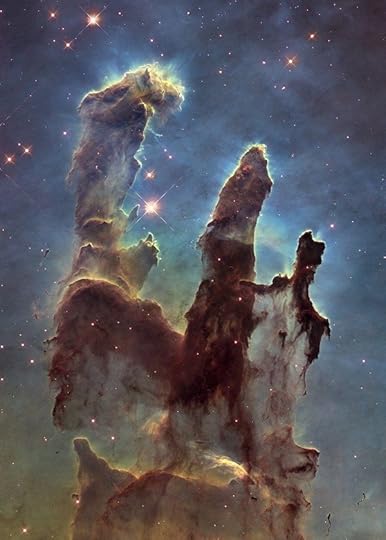
Photo: Hubblesite
In 2014, the Hubble Telescope shot the same spot with upgraded equipment. Most notably for us, it took a photo in near-infrared light, and the result may be even more striking. The pillars seem to be surrounded by a bright blue sparkle that emanates outward. NASA described this as “intense ultraviolet radiation from a cluster of young, massive stars and evaporating away into space.” Staring at the photo, we’re having a tough time not getting lost and following suit. 

More like this: These constellations are in full force this spring. Here’s when to watch them.
The post Get lost in NASA’s famous ‘Pillars of Creation’ photos appeared first on Matador Network.
Matador Network's Blog
- Matador Network's profile
- 6 followers



